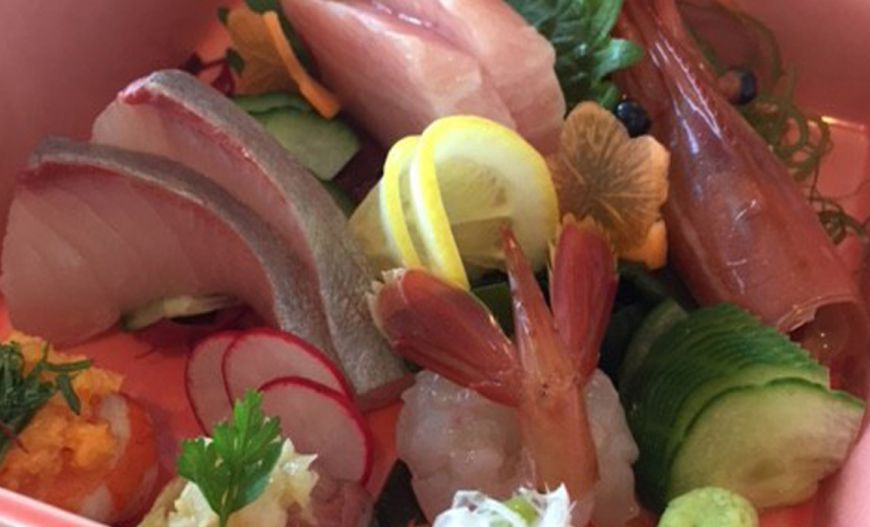A Glimpse Into the Tea Ceremony (Part 3)
- Holly Helt

To conclude this tea ceremony series, we will look at the formal setting and the sitting. Most of what is written about the tea ceremony is done in a serious tone. This is my take on what it is really like. Let’s be honest.
The Chaji, as opposed to the Chakai, is a much more formal affair: a full-blown four- or five-hour meal and two tea ceremonies.
Usually by the time you’ve eaten for hours, you only want one sip of tea. Your host understands this and makes one bowl of “thick” (koicha) tea for the room, meaning everyone drinks from the same bowl and passes it along.
The more formal Chaji involves cha-kaiseki, sort of like haute cuisine. I use the term “meal” loosely as it’s more like art than food. You are expected to eat the food with your mind and then slip it into your mouth. This is not at all hard to do because the food is so exquisitely presented that you literally contemplate how on earth they did it!
The meal has quite a few liquids, represents all the flavor groups, and is followed by a formal tea ceremony with koicha (thick matcha tea). This is unlike anything most people have tasted. It always reminds me of pudding by the thick texture and yes, it is an acquired taste. Make absolutely sure you prep your palate with the sweet (wagashi).
The engagement usually ends with “relaxation time” over usucha (thin tea) and another wagashi sweet. Usucha signals the end of the gathering in the most respectful but authoritative way. In other words, it’s time to go home!
Most foreigners don’t often get invited to this long session because we start breaking the rules before we even get there! If you’re lucky enough to be invited, make sure to stop by the host’s home in advance to express your gratitude for the invitation. But don’t make a fuss about it. That would be considered rude.
Let’s say you are invited...
The idea of attending Chaji kicks in and now you are imagining “WOW! Five hours with friends, food and libations! It’s gonna be awesome - like a jolly British piss up or a night out at Hooters!”
But no...
The Teahouse
When you arrive, a “dewy path” leads to the teahouse or home, even if it looks like water splashed on the pavement: Which it is. This wet path is often a sign of welcome in Japan but it has much deeper meaning in the tea ceremony. The watered path represents the transition from the outside world - regarded as the “floating world of dust” - and the purity inside the simple, rustic teahouse. Each step on the dewy path takes you further away from the outside world. In crude terms: Essentially you’re cleaning your feet of all the past “dirt”.
The doorway is tiny and low, which means you have to stoop to enter. This thoughtful feature was designed to make everyone - even feudal Lords - bow upon entering out of respect for each other: The host and the ritual. Everyone inside the teahouse is equal regardless of his or her status in the world: Be it the Queen of England, a farmer, or your little sister. Just as samurai would have to leave their ornate swords outside the door, today it is polite - and sometimes requested of you - to remove any signs that might suggest your status, like a huge diamond or that 1933 gold Patek Phillipe watch.
At the doorway, pray you don’t have holes in your socks and that they are brilliant white or better yet never worn. Wear shoes that are easy to put on and take off. This is critical! One guest I encountered had boots that laced up to her knee. It was excruciating watching the Japanese guests squirm in discomfort as they waited, implying that they might be pressuring her to hurry.
There is an order to everything in Japan - including the ranking of guests at a tea party - even though everyone is to be considered equal. The oldest - who is usually the most experienced at the formalities - is called the Shokyaku. You will understand who this is almost immediately and they might even be introduced as such. She or he will be seated in the first position in an attempt to provide comfort to the guests by showing everyone what to do by simply going first. The other guests will mimic their actions. Your role as foreigner will likely be the middle-seated guest, called Jikyaku. You can simply follow along.
Starting from the décor, everything in the teahouse is there for a reason: To keep your mind focused on the present moment. As a matter of fact, there is nothing in the teahouse except perhaps a beautiful scroll written in calligraphy or vase of flowers, arranged with meticulous care depending on the meaning of the ceremony and purposefully set in the alcove or on the floor. Everything is to be acknowledged quietly and respected, so follow the Shokyaku. There are absolutely no distractions apart from what you conjure up in your head, and for foreigners there’s usually a lot of head chatter going on.
Sitting in Seiza
Shoes off, you will be escorted onto the tatami floor to sit in “seiza”: On your knees with your butt resting on your heels. You will be shown where to sit, so no worries there. Foreigners are usually offered a cushion or some other lifting device, often followed by an apology for society making you sit this way.
“Oh, this is easy,” you announce...until 15 minutes go by, the third dish out of 20 is approaching, and your thoughts move from the serene moment to sheer panic. The only thing you can think about is shifting your weight! Discomfort morphs into outright pain. As the minutes pound by, sweat beads illuminate your forehead as the pain intensifies. You then do what every foreigner does: Glance around the room and - as subtly as possible - change position, hoping no one notices.
If you pretend to be cool and stay seated in seiza until the end, it’s guaranteed that the side of your face will crash onto the tatami mat when you try to get up. All feeling has flooded out of your feet, and I mean ALL.
No pins and needles anymore, just nothingness...
“Was this the point?” you wonder, as you immediately look down in search of your feet. You are sure they’ve left your body and are walking out the door with the nimble Japanese!
But on a serious note, if you get the chance to attend, GO! Your life will never be the same.

About Holly Helt
Holly is American and grew up in Japan drinking Japanese tea from age-three. She has studied two methods of tea ceremony, Urasenke and the lesser-known Yabunouchi, which has a direct lineage to Sen-no Rikyu (known as the father of the tea ceremony) ; it's also the school of practice for samurai. In 2012 she founded Chiki Tea - an online retailer of Japanese green teas, all sourced directly from small farms in Japan. Splitting her time between Japan and her home in Texas, Holly strives to bring the best teas from Japan to as many people as she can find to share in her life's passion.
